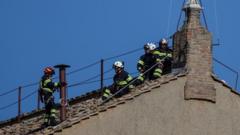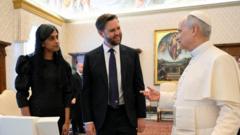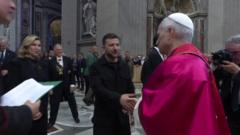The upcoming conclave at the Vatican revives centuries-old rituals that merge complex engineering with symbolic significance as the world awaits the next papal announcement.
The Secrets Behind the Vatican's Smoke Signals in Papal Elections

The Secrets Behind the Vatican's Smoke Signals in Papal Elections
Exploring the engineering and tradition that fuels the Vatican's unique announcement of a new pope.
The tradition of signaling the election of a new pope through smoke rising from the Sistine Chapel has been captivating audiences for centuries. When black smoke billows forth, it indicates that the cardinals have not yet chosen a new pope. Conversely, white smoke signifies that a new leader of the Catholic Church has been established, prompting the proclamation of "Habemus Papam" – we have a pope. This compelling event, broadcast globally, conceals intricate layers of planning and precision.
Following the recent passing of Pope Francis, the focus is now on the conclave, where cardinals will convene in St. Peter's Basilica on May 7 for Mass before participating in the crucial voting process within the Sistine Chapel. Experts have noted that the use of smoke to convey results dates back to the 15th century, evolving from a necessity to maintain confidentiality amidst public distress regarding past electoral delays.
Professor Candida Moss from the University of Birmingham highlights the significance of the smoke as a historical form of communication with the divine, linking the event to ancient traditions. As the smoke ascends, it creates a sense of inclusion among those gathered in St. Peter’s Square, enhancing the mystical atmosphere surrounding the election.
A contemporary approach to this ancient tradition involves meticulous engineering. Two stoves are set up in the chapel — one to incinerate ballots and another to generate the smoke signals. These stoves are connected to a discreetly installed chimney, which exits through the rooftop of the historic structure, requiring careful installation to protect the chapel's celebrated interior.
The engineering process is rigorous, with technicians ensuring that the smoke signal's visibility is clear. Various chemical combinations are used: black smoke is created from a mix of potassium perchlorate, anthracene, and sulfur, while white smoke results from potassium chlorate, lactose, and pine rosin. Two "custom fireworks" ensure that the signals are unambiguous.
Vatican firefighters are on standby during the process, as even minor malfunctions could lead to significant international ramifications. This comprehensive setup is erected shortly before the cardinals arrive and is dismantled when the new pope is confirmed.
Despite calls to modernize the communication method through digital means or colored lights, the Vatican remains committed to this historical practice, valuing the theological weight and tradition it embodies. The intersection of ritual and innovation continues to reflect a tension inherent in the Catholic Church, where modernity and religious customs often exist at odds.
Following the recent passing of Pope Francis, the focus is now on the conclave, where cardinals will convene in St. Peter's Basilica on May 7 for Mass before participating in the crucial voting process within the Sistine Chapel. Experts have noted that the use of smoke to convey results dates back to the 15th century, evolving from a necessity to maintain confidentiality amidst public distress regarding past electoral delays.
Professor Candida Moss from the University of Birmingham highlights the significance of the smoke as a historical form of communication with the divine, linking the event to ancient traditions. As the smoke ascends, it creates a sense of inclusion among those gathered in St. Peter’s Square, enhancing the mystical atmosphere surrounding the election.
A contemporary approach to this ancient tradition involves meticulous engineering. Two stoves are set up in the chapel — one to incinerate ballots and another to generate the smoke signals. These stoves are connected to a discreetly installed chimney, which exits through the rooftop of the historic structure, requiring careful installation to protect the chapel's celebrated interior.
The engineering process is rigorous, with technicians ensuring that the smoke signal's visibility is clear. Various chemical combinations are used: black smoke is created from a mix of potassium perchlorate, anthracene, and sulfur, while white smoke results from potassium chlorate, lactose, and pine rosin. Two "custom fireworks" ensure that the signals are unambiguous.
Vatican firefighters are on standby during the process, as even minor malfunctions could lead to significant international ramifications. This comprehensive setup is erected shortly before the cardinals arrive and is dismantled when the new pope is confirmed.
Despite calls to modernize the communication method through digital means or colored lights, the Vatican remains committed to this historical practice, valuing the theological weight and tradition it embodies. The intersection of ritual and innovation continues to reflect a tension inherent in the Catholic Church, where modernity and religious customs often exist at odds.




















